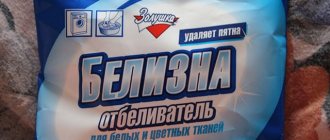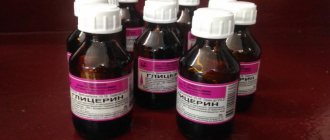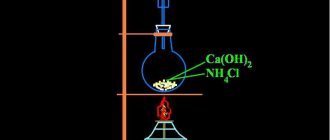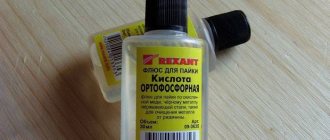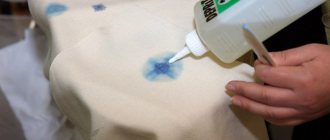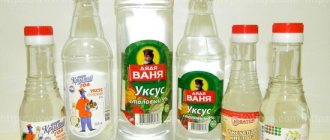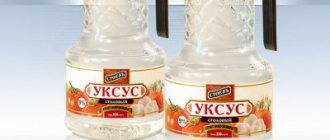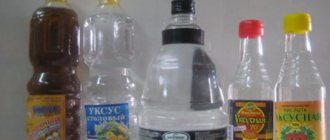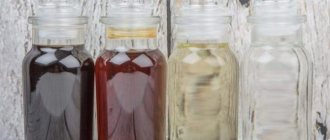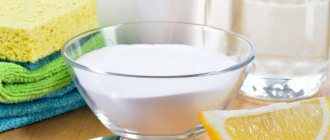Good afternoon friends!
I think you know that the use of vinegar is not limited to cooking. The ways to use vinegar are so multifaceted: from household use for washing and cleaning to medicinal uses!
By the way, I almost never use it in cooking, except for canning vegetables for the winter. Although kebab marinated in vinegar turns out soft and juicy, I still learned how to marinate it using only spices, onions and vegetable oil. But I have long replaced various chemical cleaners with table vinegar. Table white vinegar is not only a money saver, but also a fantastic, most versatile, effective natural remedy that will help you cope with many household problems.
Elimination of unpleasant odors
Vinegar removes unpleasant odors in the house. Table vinegar perfectly eliminates unpleasant odors, being a budget alternative to chemical detergents and air fresheners. An aqueous solution of vinegar can be sprayed in cabinets and corners of the apartment, as well as wipe various surfaces in the house, shelves and containers in the refrigerator. Vinegar will absorb unpleasant odors and create a feeling of cleanliness and freshness.
Using vinegar in the household
I have already written about some ways to use table vinegar and other natural cleaning products for the home. And today I will go into more detail.
So, vinegar for home use.
1. Air freshener. Vinegar is an excellent replacement for chemical air fresheners, which often have a not-so-pleasant, pungent odor. You can wipe various surfaces in the rooms with a solution of table vinegar or use a spray bottle to spray vinegar in the corners and the unpleasant odor will disappear imperceptibly.
2. Eliminating unpleasant odors in the refrigerator . A vinegar-water solution helps absorb unpleasant odors in the refrigerator and food containers. To do this, simply wipe the surface with a cloth soaked in vinegar.
3. Cleaning cutting boards . By wiping wooden cutting boards with vinegar, we get rid of not only the unpleasant odor, but also harmful microbes.
4. Washing glass, plastic and stainless steel . Glass and plastic dishes and other things will shine if you also wipe them with vinegar diluted in half with water.
To clean stainless steel and chrome, you can mix vinegar and baking soda. I love using this mixture to clean the surface of a gas stove. Everything just cleans and shines without any effort!
To clean copper and brass surfaces, make the following paste: mix a cup of vinegar with a teaspoon of salt, add a cup of flour, apply to the surface for 15 minutes. Then rinse with water and polish with a dry cloth.
You can also use vinegar to clean kitchen furniture.
5. Cleaning the oven . Vinegar is often used to clean the oven from carbon deposits and grease. I have a separate detailed article on this topic, I will not repeat it.
6. Cleaning baths, toilets and showers . To clean bathtubs and toilets, use a mixture of vinegar and soda again. The mixture is used as a scrub, the surfaces are cleaned and washed off with water.
To disinfect rooms to kill germs, vinegar is sprayed onto all surfaces and corners of the bathroom.
To clean the shower head from corrosion and salt deposits, you need to place it in a tight bag with vinegar, tie it and hold it there for an hour. Then rinse with water.
If you have a permanent shower and this procedure is impossible, try soaking a cloth in vinegar and wrapping it around the shower head.
7. Cleaning tiles . To clean tiles and grout from mold, mix a cup each of vinegar, ammonia and water and a half cup of baking soda.
For convenience, you can use a toothbrush.
8. Cleaning ceramic surfaces . Using the same toothbrush dipped in vinegar can clean ceramics perfectly.
9. Descaling . To descale a kettle, boil water in it and add a little vinegar.
10. Removing stains from clothes . To remove sweat stains on clothes, you can moisten the stain with vinegar, leave for 10 minutes, and then wash the item.
You can do the following: mix vinegar with an equal amount of water and soak things in this solution for several hours. This method should get rid of many stains.
How else can you remove various stains from clothes>>
11. Using vinegar when washing . Using table vinegar every time you wash will help solve many problems:
will rid clothes of the unpleasant odor, which often comes from men's shirts or accumulated dirty laundry, and give them freshness;
the use of table vinegar softens clothes better than any chemical, it is both cheap and useful for the washing machine;
vinegar helps preserve and restore the color of clothes, because frequent washing causes dark and colored clothes to become dull; vinegar can help cope with this problem;
Vinegar can also act as an antistatic agent, so it is indispensable when washing nylon and other synthetic clothing.
Always keep a bottle of table vinegar at home and add half a glass of vinegar to the washing machine drum when washing.
12. Bleaching things . Pour a cup of vinegar into a large saucepan of water and bring to a boil. Turn off the heat, immerse kitchen towels or socks in the water and leave to stand overnight. After washing, things will become snow-white again.
13. Washing children's toys . Almost all young children put toys in their mouth, so they need to be washed and washed frequently. No chemicals can be used here. Pour 4 liters of water into a bucket and add a cup of white table vinegar. Place the toys in a bucket of water and let them lie there for an hour and soak. All that remains is to rinse well with water and dry in the sun. The toys will become clean, and the child will not be afraid to put them in his mouth again.
14. Cleaning the iron . In order to clean the soleplate of the iron, it is enough to wipe it with vinegar. To clean the inside, pour vinegar into the steam compartment, place the iron in a vertical position and turn on the steam mode for 10 minutes. Then you need to thoroughly rinse the compartment with water.
Read more about how you can clean your iron at home>>
15. Peeling off price tags . How often do you have to suffer to peel off price tags from new things or some stickers on cans, wooden and plastic surfaces. But you can use vinegar here too. You need to warm it up a little, moisten a sponge in it and attach it to the price tag or sticker. There won't even be any sticky residue left!
16. Removing rust . Soak small items (bolts, nuts, tools) in vinegar for several days or boil them with vinegar. Next, we wash them with water and there are no traces of rust!
17. Peeling off wallpaper . I didn’t know that vinegar helps peel off old wallpaper, I was just doing this recently. You need to mix vinegar and water in equal proportions and spray it on the wallpaper using a spray bottle; you can wet the wallpaper with a sponge. Let it sit for a while and then the wallpaper will easily come off the wall.
18. Removing paint from a brush. Dried paint dissolves perfectly in hot vinegar. Keep the brush in it for half an hour and then rinse in soapy water and rinse in clean water. Your brushes will be as good as new, clean and with soft bristles.
But that's not all the ways to use vinegar!
19. Getting rid of ants . Vinegar is a safe and effective repellent, driving away ants and other insects once you wash your countertops with the vinegar solution.
You can also spray vinegar diluted with water in the places where ants appeared, and they will no longer appear.
20. Preserving bouquets . In order to extend the life of the bouquet and admire it longer, add 1 spoon of bite and 2 sugar to the water.
How to preserve a bouquet of flowers in a vase longer: general rules and detailed recommendations.
Air freshener
The fact that vinegar successfully copes with the smell of fish is already a serious indicator. But what about the unpleasant odor in the toilet, the smell of dampness in the pantry or the corrosive aroma of tobacco smoke? You can also get rid of all these “charms” without much difficulty. It is enough just to mix equal parts of water and table (3-9%) vinegar.
It is recommended to pour the resulting product into a spray bottle. In this case, the solution is sprayed into the air or applied to surfaces, followed by removing excess with a sponge or microfiber cloth. But you can do without an “intermediary” by moistening the rags used during cleaning in this mixture. And in the toilet and living room, you can simply leave a sponge soaked in vinegar - it will evaporate, neutralizing unpleasant odors.
When cleaning a refrigerator, the mixture is also very effective - simply wiping the shelves with this product can get rid of even quite persistent odors. But if you heat this solution in the oven or microwave for 5 minutes, then not only will the smell disappear, but the fat will no longer resist removal with a simple sponge.
Vinegar has an antiseptic effect, destroying many types of microorganisms and mold.
By the way, if you treat furniture with a solution, you can not only refresh it, but also ward off pets. Cats are especially sensitive to this product - after this they lose interest even in those corners that were chosen as scratching posts.
It also helps if there is an embarrassment with your pet: after cleaning up the consequences of the “accident”, this place needs to be wiped with vinegar. After such a simple treatment, neither stains nor smell will give away the “crime scene.”
@esoraeluxury.com
How is vinegar different from vinegar essence?
Vinegar and vinegar essence are two different products, and it is better not to confuse them to avoid trouble. What's the difference? In the amount of acid: in vinegar it is no more than 15% (usually 3, 6 or 9%), in essence - from 70 to 80%. We can safely add the first product to food in its pure form, the second must be diluted and used with caution, strictly measuring the required amount.
A solution containing 100% acetic acid is called “glacial acid”; it is impossible to find it on the market because it is a toxic substance.
As a rule, vinegar essence is produced chemically. At home, it must first be diluted with water to obtain a culinary ingredient or all-purpose cleaner. This is not always convenient, because it is easy to make a mistake and violate the proportion, thereby ruining the dish or the surface of the furniture.
Calorie content and chemical composition
The calorie content and chemical composition of vinegar vary depending on which of its many types we are talking about. If a purified synthetic product contains only water and acetic acid, then the natural product contains a variety of food acids (malic, citric, etc.), as well as micro- and macroelements.
For windows and mirrors
In order to get rid of dirt on windows and mirrors, I add vinegar to water in a 1:1 ratio. Mine in my usual way. After using this method, windows and mirrors shine, there are no streaks or glare. You can also wipe your glasses with vinegar. But be sure to wipe the glass with a dry cloth after use.
Thanks to vinegar, there will be no streaks left on glass or mirrors (Photo: perumana.com)
And that's not all! Do you have a pet? Remember:
- Did your dog give you a “pleasant” surprise? Dampen a rag and wipe the affected area, the stains and smell will disappear;
- It will make the coat shiny and smooth, and help get rid of fleas. Mix with water and spray the animal, the main thing is not to overdo it;
- What if you have a cat? The vinegar will help eliminate the smell coming from the litter box. Just wash it with the product the next time you clean it.
There are many more ways to use vinegar, but not all of them are confirmed by practice, and some are even dangerous. The functionality of this ingredient is simply off the charts, and now you are aware of most of its capabilities. We hope that after our advice it will become easier for you to keep your home clean and tidy. Good luck!
Harm and contraindications
The beneficial properties of different types of vinegar were mentioned above. However, if consumed in excess, even natural vinegar can cause serious damage to health.
Best materials of the month
- Coronaviruses: SARS-CoV-2 (COVID-19)
- Antibiotics for the prevention and treatment of COVID-19: how effective are they?
- The most common "office" diseases
- Does vodka kill coronavirus?
- How to stay alive on our roads?
The high content of natural acids can worsen the condition of people suffering from diseases of the gastrointestinal tract. Thus, those who have been diagnosed with gastritis and pancreatitis, ulcerative lesions of the stomach and intestines, as well as colitis or cholecystitis should exclude all types of vinegar from the diet.
This product is also harmful to tooth enamel and can cause an allergic reaction in case of individual intolerance.
Use for washing:
- Perfect for removing wine stains on any fabric;
- Again, for lovers of bright colors. When you rinse red or blue fabric, add a little vinegar, you will be pleased with the result;
- Who, if not you, knows that price tags on clothes leave terrible marks. Place a napkin soaked in vinegar on them, and this problem will not affect you again;
- Suede material tends to harden. To make it softer, rub it with vinegar;
- It will clean the umbrella well from all kinds of plaque and stains. Dilute with water and pour into a spray bottle, then spray and wait. After an hour, rinse with water.
Types and varieties
As noted above, all types of vinegar are divided into two categories depending on the method by which the product is obtained: synthetic or natural.
Synthetic vinegar
Synthetic, also known as table vinegar, is still the most common in post-Soviet territory. It is most often used when canning vegetables, as a leavening agent for dough and as a flavoring additive. It is also used for medicinal purposes.
Such a product is obtained as a result of a chemical reaction - the synthesis of natural gas or the sublimation of wood. This technology was first used back in 1898; since then some changes have been made to it, but the essence itself has remained unchanged.
It is noteworthy that in terms of taste and aroma characteristics, a product of synthetic origin “dry” is inferior to its natural counterpart. At the same time, it has one important trump card: the fact that the technological process of its production is not expensive.
The main area of use of synthetic vinegar is cooking. It is mainly used as an ingredient in marinades in the preparation of dishes from meat, fish and vegetables. Due to the disinfecting properties of the substance, products that have been pickled with its help have a longer shelf life.
In addition, synthetically produced vinegar is used in households for disinfection and many other purposes.
The calorie content of this product does not exceed 11 kcal per 100 g. Of the nutrients, it contains only carbohydrates (3 g), and no proteins or fats.
If we talk about natural types, then the raw materials for their production are grape wine, apple cider, beer wort and various fruit and berry juices in which the fermentation process has begun.
Apple vinegar
Today it is presented on the market in two form factors: liquid and tablets. Still, liquid apple cider vinegar has traditionally been more popular. It has many areas of use: from cooking to cosmetology and dietetics.
Cooks add this product to sauces when preparing meat and fish dishes, and also use it for preservation - thanks to this ingredient, vegetables acquire a special aroma and piquant taste. Also, an apple-based product is added to puff pastry, used for dressing salads, and as a seasoning for dumplings.
Apple cider vinegar has pronounced anti-inflammatory and antifungal properties. Therefore, a solution for gargling for sore throat and tonsillitis is made on its basis.
This product is useful for anemia, as it is a natural source of iron. Also, the pectins it contains prevent the absorption of fats and the formation of atherosclerotic plaques on the walls of blood vessels, reducing the risk of heart attacks and strokes.
Due to the fact that the Ph of this substance is practically no different from the Ph of the upper layer of human skin, this product can be used for cosmetic purposes. For example, to restore skin tone, wipe it every day with a weak solution of apple cider vinegar.
The presence in the product of a number of organic acids, minerals, as well as vitamins A and B has made it popular among adherents of healthy eating. In particular, it is used for weight loss, which will be discussed below.
The calorie content of apple cider vinegar is 21 kcal per 100 g of product. There are no proteins or fats in its composition, and it contains 0.93 g of carbohydrates.
Balsamic vinegar
This product is most loved by gourmets, although in ancient times it was used exclusively as a remedy. It is first mentioned in manuscripts dating back to the eleventh century.
It is obtained from grape must, which undergoes a lengthy processing procedure. First it is filtered, then fermented in larch barrels, after which it is poured into oak wood containers, where it matures for several years. The result is a dark, thick and viscous liquid with a bright aroma and sweet and sour taste.
All balsamic vinegar is divided into three categories depending on its quality:
- Tgadizionale (traditional).
- Qualita superioge (highest quality).
- Extga veсshiо (especially seasoned).
Balsamic vinegar, presented on the shelves of most stores, is a product aged from three to ten years, while the most expensive varieties belonging to the second and third categories can age up to half a century. They are so concentrated that only a few drops are added to dishes.
Balsamic vinegar is added to soups, salads, used when preparing marinade for fish and other seafood, and sprinkled on elite varieties of cheeses. This product is especially popular among fans of Italian cuisine.
The substance contains a number of macro- and microelements, pectins, as well as organic acids. All this makes it an excellent antiseptic and effective cosmetic product.
Please note that balsamic vinegar is most often counterfeited due to its high cost. The cost of a high quality product is at least ten dollars per 50 ml.
The calorie content is 88 kcal per 100 g, it contains 0.49 g of protein and 17.03 g of carbohydrates, and there are no fats.
Vinegar
Wine vinegar is a product that is formed as a result of the natural souring of wine. It is the brainchild of French chefs and, depending on the type of wine used to prepare it, it can be white or red.
The red variety is usually made from Merlot or Cabernet. The fermentation process takes place in oak barrels. In cooking, it is used to prepare sauces, seasonings and marinades.
White wine vinegar is prepared from dry white wines, and not wooden containers are used, but containers made of ordinary stainless steel. Therefore, the manufacturing process is less expensive. It is also used for making sauces, but has a less rich taste. Cooks often use this product with added sugar to replace white wine in some dishes.
In France, wine vinegar is used to add a more piquant taste to chicken, beef and fish dishes, and is also added as a dressing to vegetable salad with grapes and cheese.
It is noteworthy that this substance has a number of medicinal properties. In particular, it contains the element resveratrol, which is a powerful cardioprotector and has antitumor and anti-inflammatory effects. This product also helps remove bad cholesterol from the body.
Calorie content is 9 kcal per 100 g. The product contains 1 g of protein, the same amount of fat and the same amount of carbohydrates.
Rice vinegar
Rice vinegar is a specialty of Asian cuisine. It is obtained from rice grains. The finished product has a delicate, mild taste and a sweetish, pleasant aroma.
There are several types of rice vinegar: white, red and black.
The white variety is made from glutinous rice. It has the most delicate taste and almost imperceptible aroma. It is usually used to prepare sashimi and sushi, marinate fish with it, and also add it as a dressing to salads.
The red variety is prepared by adding special red yeast to rice. It is characterized by a sweet-tart taste with bright fruity notes. It is added to soups and noodles, and also emphasizes the taste of seafood with its help.
Black rice vinegar is made using a mixture of a number of ingredients: long grain and glutinous rice, wheat, barley and rice husks. The finished product is dark and thick, with a rich taste and aroma. It is used as a seasoning for meat dishes, as well as stewed vegetables.
The valuable amino acids contained in the product give it healing properties. For example, in the East they believe that it can increase the body’s resistance, improve digestion, and sharpen cognitive functions.
The calorie content of rice vinegar is 54 kcal per 100 g. It contains 0.3 g of protein and 13.2 g of carbohydrates. There are no fats.
Cane vinegar
Sugarcane syrup vinegar is a common product in Indonesian cuisine. It is also popular in the Philippines.
Cane vinegar is produced by fermenting cane sugar syrup. This product is not particularly popular in the world. First of all, it has a very specific taste. In addition, it is very expensive. However, gourmets highly value cane vinegar, which is made on the island of Martinique. It is a true rarity, unlike the Philippine product, which is less expensive and more common in the region.
Cane vinegar is used when frying meat.
The energy value of the product is 18 kcal per 100 g. It contains no fats or proteins, and the carbohydrate content is 0.04 g.
Sherry vinegar
This is a type of wine vinegar. It was first produced in Andalusia from white grape varieties. A special fungus is added to grape juice, which starts the fermentation process. The resulting wort is placed in special oak barrels and aged for a long time.
The minimum aging period is six months, and elite varieties are infused for ten years.
Sherry vinegar is a specialty of Mediterranean cuisine. It is used to prepare meat and fish dishes, and seasoned with fruit and vegetable salads.
The energy value is 11 kcal per 100 g. There are no proteins or fats in the composition, and carbohydrates are 7.2 g.
Malt vinegar
Malt vinegar is a highlight of British cuisine. Outside of Foggy Albion, it is practically unknown. The raw material for its preparation is fermented beer malt wort, resulting in a product characterized by a delicate fruity flavor and color that varies from golden to bronze-brown.
There are three varieties of malt vinegar:
- Dark, intense brown color. It has a strong aroma with notes of caramel. It is used to prepare marinades for meat and fish, which ultimately acquire a tart, piquant flavor.
- Light, pale golden hue. This product has a soft aroma with subtle fruity notes. Most often it is used as a salad dressing. It is also this type of vinegar that is included in the legendary British dish fish and chips, which is fried fish and chips.
- Colorless malt vinegar. It is used for preservation. Its undeniable advantage is the fact that it helps preserve the natural color and aroma of products, but at the same time gives them a sharpness.
The calorie content of 100 g of product is 54 kcal. It contains no fats, contains 13.2 g of carbohydrates, and 0.3 g of proteins.
Gargling with apple cider vinegar for pain and sore throat
Colds and seasonal infectious diseases, for example, sore throat, are accompanied by excruciating sore throat, sore throat, and difficulty swallowing.
To gargle with apple cider vinegar, use a diluted liquid. To prevent vinegar from burning sensitive mucous membranes, take 1 tablespoon of vinegar per glass of drinking pleasantly warm water. A useful addition would be a teaspoon of soda, which softens inflamed skin, or the same amount of sea salt, which enhances the drying and antibacterial effect of the rinse.
The unique properties of vinegar that make it indispensable in everyday life
Vinegar is obtained from alcohol or alcohol-containing fruit juices (apple and others) through microbiological synthesis using special acetic acid bacteria. Vinegar is traditionally used in cooking, in particular as a preservative for winter preparations, but based on knowledge of how it is obtained, it is not difficult to guess that it can perform other tasks.
Ordinary table vinegar, combining the properties of alcohol and acid and having its own specific odor, is relatively safe for human health. Consequently, it can be used in everyday life without fear of harming yourself and loved ones for the following purposes:
- as a solvent;
- as a cleaning agent, including hard-to-reach places;
- to soften rough skin, for example on the legs;
- to neutralize odors.
Vinegar has been known to mankind since the times of Babylon, where it was prepared from dates and was consumed as widely as date wine. Also, since ancient times, vinegar has been used not only in the kitchen, but also to disinfect wounds and for other medical purposes.
Knowing how to use vinegar for household purposes, you can significantly save money and time looking for other ways and means to solve daily cleaning tasks, etc.
Apple cider vinegar for body skin
Natural apple cider vinegar benefits not only the face, but also other parts of the body, as well as hair. Organic acids, which have antibacterial, anti-inflammatory, and refreshing effects, are indispensable for insect bites. Using apple cider vinegar as a lotion allows you to:
- relieve itching;
- reduce swelling and redness;
- neutralize the effect of toxic substances injected into the skin by insects.
The active substances in vinegar have long been used in hair care, namely when rinsing strands, in masks and tonics. Vinegar is most useful for oily hair that is prone to loss of volume and dandruff.
Components of natural liquid:
- perfectly smooths unruly strands;
- eliminate the cause of the appearance and dandruff itself;
- give curls a vibrant shine;
- simplifies combing;
- refreshes hair.
Folk remedies using apple cider vinegar for toenail fungus have long been famous. Not only does the acidic liquid perfectly deodorize and refresh the skin, it:
- inhibits the activity of pathogenic microorganisms;
- loosens keratinized areas and promotes active skin renewal;
- prevents the appearance of cracks and the development of secondary infection.
To eliminate sweaty feet and fight fungal disease, use local foot baths based on 200 ml of apple cider vinegar and five liters of warm water. Feet are immersed in the solution for 20 minutes before bedtime. A lotion made from equal parts of a bite and baking soda helps to defeat the fungus. The paste is applied to the affected areas for half an hour, then washed off, and the feet are blotted with a soft towel.
Apple cider vinegar for gout
Gout, which causes joint deformation, chronic pain and other signs of discomfort, is a difficult disease to treat. Most often, patients need effective pain relief, normalization of metabolism, physical therapy, and even surgical intervention.
Apple bite for gout is used externally as a component of medicinal ointments, compresses and refreshing, pain-relieving baths.
To make an ointment, take one raw yolk and a teaspoon of turpentine per tablespoon of vinegar. After thorough mixing, the composition is applied to the affected joints, accompanying the procedure with a light massage. No less useful are compresses and warm baths with natural vinegar diluted with clean water.
